This could be the most festive way we have ever experienced to celebrate the season. Join us on a day by day account of a holiday cruise along the Danube. The cheer factor was off the charts!

We’re excited to bring you along on our waltz down the Danube as we visit the Christmas markets of Hungary, Slovakia, Austria, and Germany.
Our journey takes us to four UNESCO World Heritage Sites, ensuring immersion into the grand history of the area.
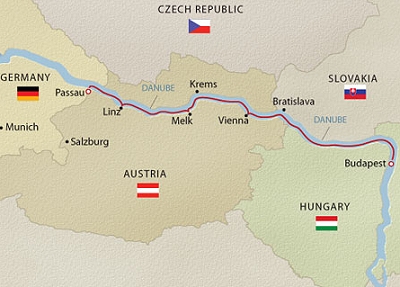
We will be sure to pay special attention to the unique culture and customs surrounding the holiday along the River Danube, including gingerbread making, mulled wine sampling and, of course, the wares of the Christmas markets.
Day One: Arriving in Budapest and Meeting Skadi
Afternoon: Beam me up Skadi
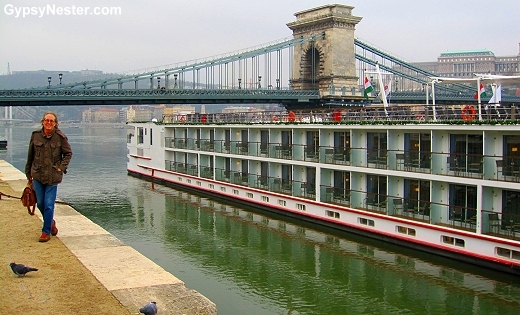
We catch our first glimpse of our home for the next eight days. We’re docked right under Budapest’s famed Chain Bridge!

We are treated to a welcome drink in the beautiful lounge upon boarding
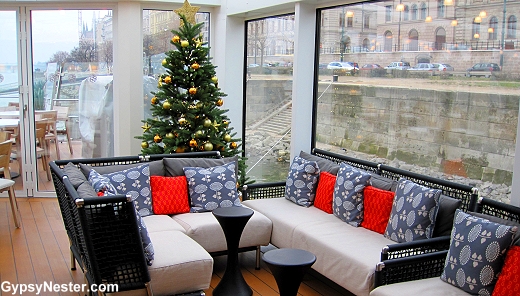
Skadi all dolled up for Christmas. Look at the windows – the entire ship is like this!
Welcome to our stateroom!
Evening: Budapest’s Christmas Market
Our Christmastime tour of the Danube begins in Budapest. At two million people, the Hungarian capital is the largest city we will see on this journey, in fact it is the biggest city on the entire river.
After checking in on the ship and stowing our gear, we head into the heart of the city to check out the first of several Christmas Markets we plan to visit over the next few days.
First things first, a cup of steaming hot Glühwein to warm our bodies and souls.
German for “glow-wine,” not because of the warm glow it gives a body, but from the hot irons used for mulling in days gone by.
The Hungarian version of hot mulled wine is called forralt bor, meaning simply “boiled wine.”
See more of our adventure in Budapest!
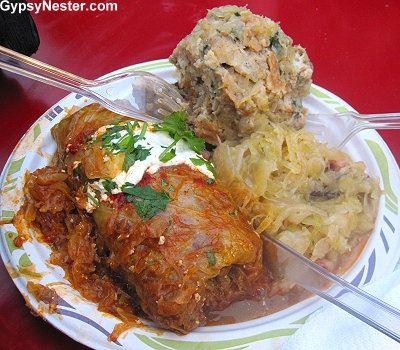
The market is teaming with activity, booths selling handcrafted gifts, and food, lots of food!
After checking all the offerings we order a töltött káposzta, cabbage stuffed with meat and rice and served with a paprika sauce and sour cream. Exceedingly Hungarian! We also couldn’t resist a huge smoked meat dumpling with sauerkraut.

Best jet-lag cure, total immersion into the local food and customs.
See more photos of Budapest’s bustling Christmas Market!
Day Two: Discovering Buda AND Pest (you think we’re kidding, but we’re not!)
Morning: Buda
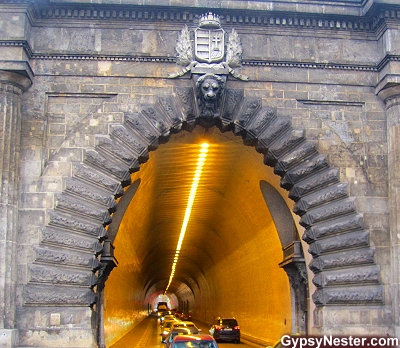
Tunneling through the old city wall of Buda
Buda and Pest. Until 1873 these were separate cities with The Danube dividing them.
With just one day to attempt to see as much of both as we possibly can, we begin on the Buda side in the neighborhood around the old castle and royal palace.
Buda has been the spot for rulers and royals for nearly 700 years. These days the president lives up here as opposed to a king.
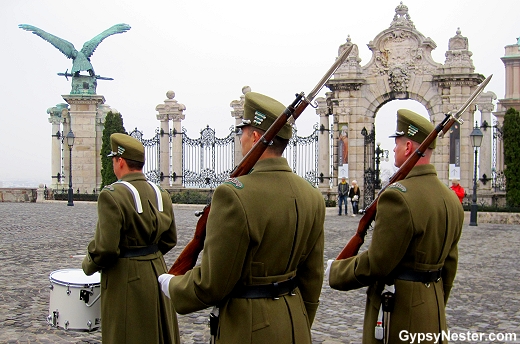
The Changing of the Guard

Looking up at Fisherman’s Bastion
On top of the ancient walls of the city, a bastion of seven lookout towers was constructed in 1905.
No longer needed for defense, it is instead a tribute to the seven tribes that established Hungary over a thousand years ago.
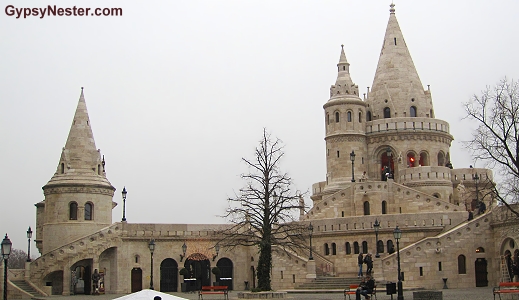
Fisherman’s Bastion at the top
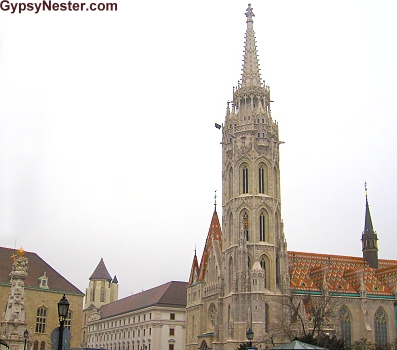
Within the bastion, Matthias Church serves as the second most important church in Budapest.
It is built in a Byzantine style to reflect the eastern heritage of the Hungarian people.
The fortifications also surround a statue of King/Saint Stephen, who was crowned in the year 1000 and brought Christianity to Hungary. The church in his honor is on The Pest side of the river and serves as the main cathedral for the unified city.
Follow us into the gorgeous Matthias Church
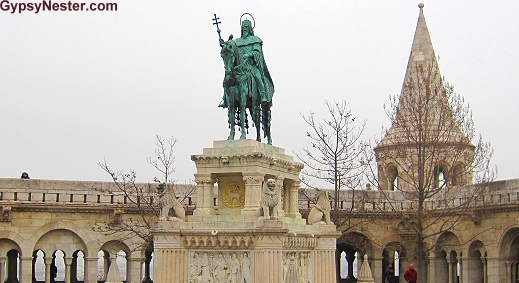
See more of our adventure in Budapest!
Afternoon: Pest
Having spent the morning in Buda, we cross over to Pest on the famous Chain Bridge, one of eight spans that connect the two old cities to make the new Budapest.
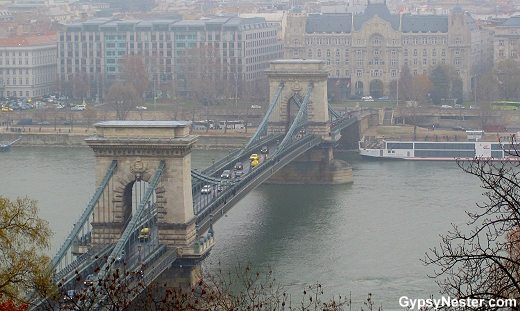

Along the river we pass the Parliament House, and just in front of it The Shoes on the Danube, a memorial to the Jewish people who perished during World War II. Victims were lined up on the river bank so the current would carry their bodies away. They were ordered to remove their shoes first because it was believed that they were too valuable. Very moving.
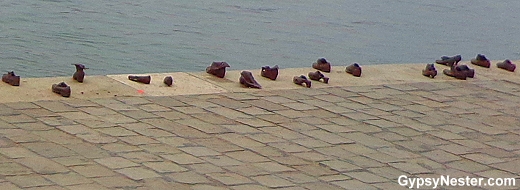
Hősök tere, Heroes’ Square, is the city’s main plaza dominated by the Millennium Monument. The monument was built in 1896 to commemorate the thousandth anniversary of the founding of Hungary in the late 9th century. Statues of the leaders of the seven tribes that came here from Asia are depicted around the main column topped by the archangel Gabriel holding a replica of the royal crown.
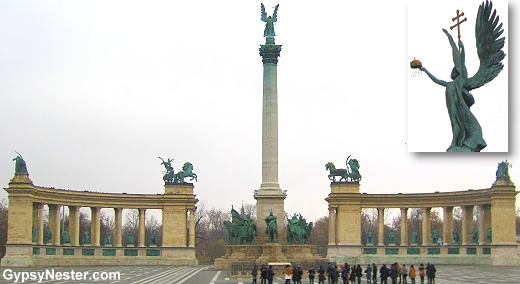
See more of our adventure in Budapest!
Later in the Afternoon: Climbing to the top of Budapest and being handy
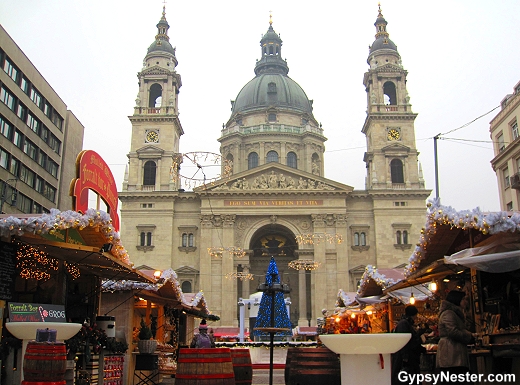
The Christmas Market in front of St. Stephen’s Basilica
Szent István Bazilika, St. Stephen’s Basilica, serves as the main church for Budapest. Without really knowing what to expect, we buy tickets to go up in the tower. Climbing the seemingly endless stairs, we’re just sure there must be something really good at the top. Three hundred feet up we’re not disappointed.
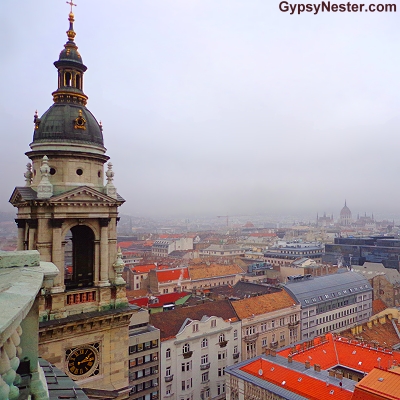 The Parliament Dome is off in the distance in the fog
The Parliament Dome is off in the distance in the fog
From the top of the cathedral dome we get a 360 degree panoramic view of the entire city. It certainly seems to be the highest spot in town, then we learn that the dome on the parliament building is the exact same height.
This was done intentionally, to show the equality of political and religious power. By law, no building can be erected higher than the ninety-six meters of these two domes.
Inside the basilica, the king who became the patron saint of Hungary is honored in several ways, including a display of his right hand.
Yes, the one thousand year old mummified hand of Saint Stephen is kept in a glass case in a small chapel at the back of the church!
Evening: Getting goulash and a tiny little run-in with a policeman!
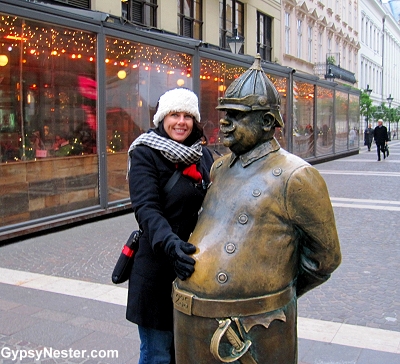
A block or two from the basilica on Zrínyi utca we met this bronze Hungarian policeman from the early 1900s.
Veronica seems to think his belly needs a pat.
Making our way back toward Skadi we stop to warm up with some hot soup.
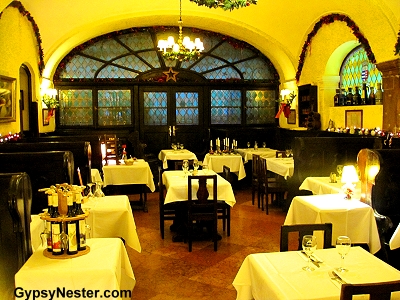
Goulash and fish soup are both classic, typical Hungarian dishes, and what better place to try them the the self-proclaimed oldest restaurant in Budapest?
The name 100 Éves Etterem, One Hundred Years Old Restaurant, doesn’t really tell the story since it was adopted in the 1930s. 180 years old would be more accurate, but hey, they can’t go changing the name every year now can they?

No matter, the soups really hit the spot.
Both heavy on the paprika, this is Hungary after all, the goulash was full of meat, potatoes and carrots, and the fish soup had big chunks of fish with hearty noodles.
Warmed up, we finish our day along the main shopping street of the city, Váci utca, all decked out in holiday finery.
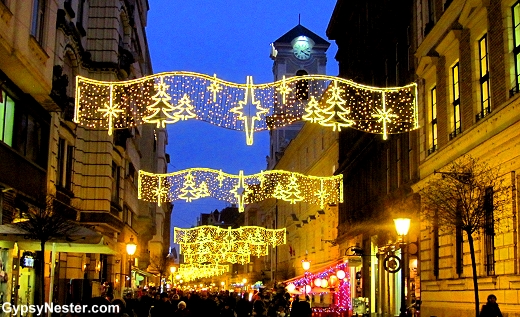
Night: Leaving Budapest: A send off we’ll remember for the rest of our lives!
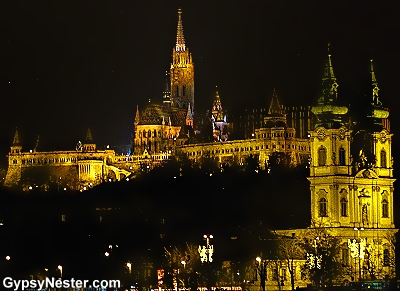
Sailing out of Budapest under The Liberty Bridge, The Chain Bridge, and The Elizabeth bridge gives us an incredible nighttime view of several landmarks.
On the Buda side we see the palace and Fisherman’s Bastion lit against the night sky.
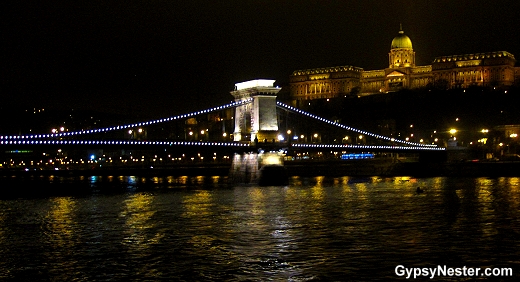
On the Pest side of The Danube, The Parliament Building is stunning as it glows in the foggy darkness. A remarkable send off after two amazing days in Budapest.
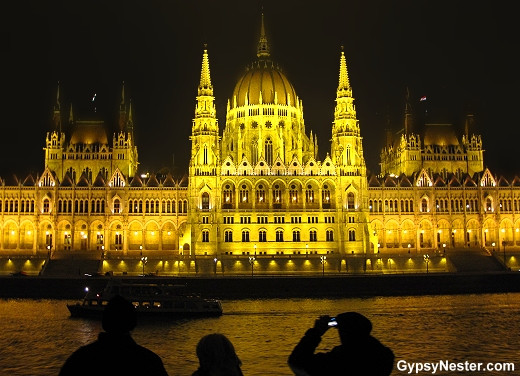
See more of our adventure in Budapest!
Day Three: Bratislava, Slovakia
Morning: Locks in Bed
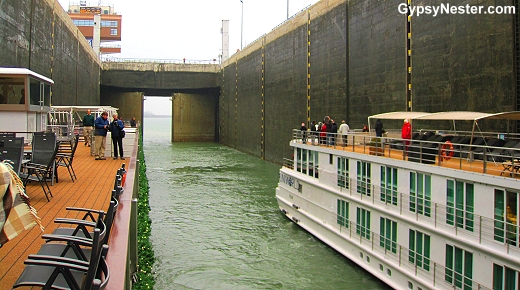

SO close to the wall!
David watching us rise on our stateroom balcony!
We are sailing upstream, which means we must pass through several locks to rise in elevation as we go along.
Skadi moves into position and then water tight doors close behind her. The lock is filled, raising us to match the river level on the high side. Then the doors open and once again we are on our way.
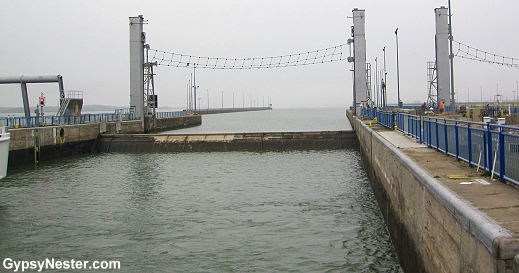
Afternoon: Storming the Castle
Although the city of Bratislava has played an important role in the history of central Europe for centuries, dating all the way back to Roman times and even serving as the capital of Hungary for over two hundred years, the name is actually quite new.
Not until 1919, when the new country of Czechoslovakia was formed, was the name Bratislava officially adopted. Before that it was known as Pressburg in German or Pozsony in Hungarian.
We began our exploration above the river at the Bratislava Castle. Up here the fog is freezing on to everything it touches, making icy art out of the trees.
This strategic spot overlooking the Danube has had some sort of fortification since the Romans arrived over two thousand years ago. Then around 1,200 years ago the Slavs came and built the first stone fortress.
Over time it was added to and improved until 1531 when the Kingdom of Hungary chose this as their capital and the castle served as the seat of power until well into the 1800s.
After that it fell into disrepair, but has been wonderfully restored over the past fifty years.
See more beautiful Bratislava!
Evening: Old Town and The Christmas Market
Below the castle we enter the old town through Michael’s Gate, named for the Archangel Michael whose statue sits atop the one hundred and fifty foot high tower.
Built around 1300, this was one of four entrances through the old protective walls, and is one of the city’s oldest structures.
The area inside the old walls has been closed to vehicle traffic so it makes for a very pleasant stroll through the cobblestone streets.
We discover the Christmas Market in front of Old Town Hall in the center of the old town.
The Hlavne namestie, main square, is filled with booths, mostly selling food and drink, and tables under small shelters where the purchases can be enjoyed.
A very social situation that we are very happy to jump in the middle of.
Nearly everyone warms themselves with varene vino, the local version of mulled wine, but in a twist we hadn’t seen before, hot white wine seems just as popular as the red.
We also gave zemiakové placky with cheese a try. This is a pancake made of shredded potatoes — crisp on the outside and chewy within — covered in a layer of mild, yet tangy white sheep cheese.
Very tasty and stick-to-your-ribs on a chilly December evening.
See more beautiful Bratislava!
Night: Food and Fun on Skadi
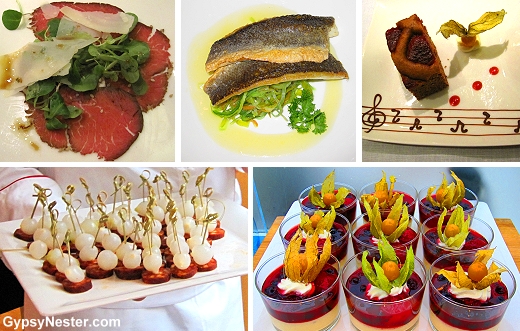
Dinner on board the Longship Skadi is another fine meal, as all of the fare has been so far. Careful attention is given to preparing local ingredients and dishes and local wines are served. We’ve even been greeted with a smile and yummy morsel when coming in from an excursion! Serving both visually and palate-pleasing dishes is accomplished flawlessly, and dare we say, artistically.
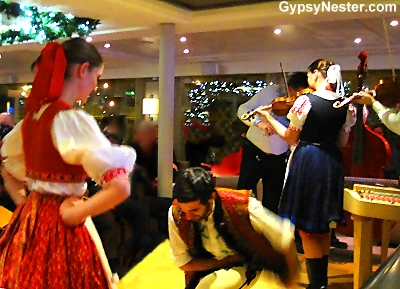
After dinner a group of Slovak musicians come aboard to entertain us.
Traditional folk songs played on dulcimer, violin, and double bass accompany the lively singers and dancers.
Day Four: Vienna, Austria
Morning: Hapsburgs and the most solid (heavy? substantial?) city we’ve ever seen!*
The city of Vienna is completely dominated by the heritage of The Hapsburgs. The dynasty ruled the Holy Roman Empire, then the Austrian Empire, and finally the Austro-Hungarian Empire from here for over 600 years, until 1918. Their palaces, churches, and government buildings are everywhere in the old city center.
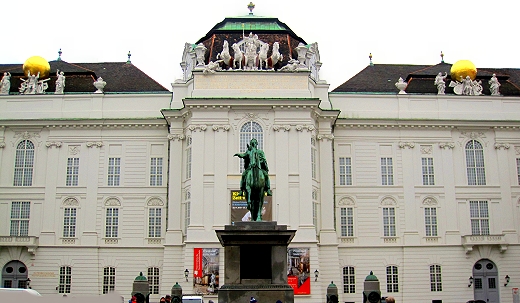
See more about our adventures in Vienna!
<
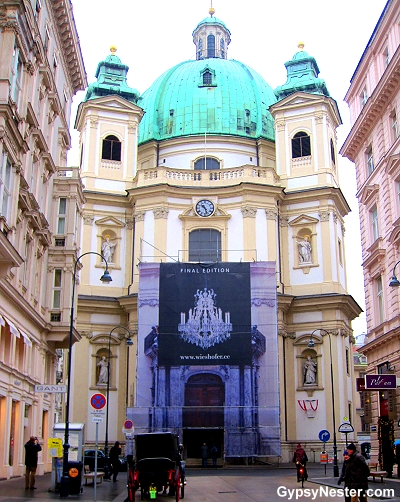
The Hapsburgs used marriage to solidify relations with most of the royal houses of Europe, therefore avoiding a great deal of conflict.
None excelled at this better than Empress Maria Theresia who married off all of her daughters, including Marie Antoinette, in arraigned marriages. With one exception, her favorite, Maria Christina.
Christina was allowed to marry for love and so with her husband Prince Albert of Saxony became a bit like the Brangelina of their day. In fact the prince even built an art museum and used their combined names, Albertina.

A less-than-flattering rendition of King Leopold I on the Plague Monument, our guide jokes that perhaps he hadn’t paid the artist enough!
A later Hapsburg ruler, Leopold I, fled the city when plague hit in 1679, but vowed to return and erect a mercy column if the epidemic would end.
The Pestsäule he commissioned is now one of the main monuments in the center of Vienna.
Afternoon: Kaffeehauskultur – yeah, baby
Coffeehouse culture has a long tradition in Vienna.
We were stopped by a life-sized figure of a woman, made entirely of sugar, standing in the window of Café Demel.
Seems like as good as any place to grab a cup of joe and dip a toe in the culture.
Founded in 1786, Café Demel certainly has the pedigree to be one of the city’s top coffeehouses, but it is perhaps better known as a sweet shop.
On our way to a table we passed the bakery, which is glass encased so we could watch all of the sensations being created.
A kind of confectioners aquarium.
See more about our adventures in Vienna!
Evening: The Original Christmas Market
Vienna can make a claim to having the original Christmas market.
Their December Market was the forerunner of the modern version and dates back to 1294.
The Wiener Christkindlmarkt in the Rathausplatz, the plaza in front of the town hall, is the city’s premier advent market.
See more photos of Vienna’s Christmas Market
As with all of the Christmas markets we’ve seen, food is a huge component.
This is Vienna, so we must have a sausage, or two. And, of course, a steaming mug of Glühwein to ward off the chill.
We must say, these Vienna sausages are much better than their namesake in the United States that come in a can!
Day Five: Small-Town Austria on The Danube
Morning: Dürnstein
Two ports of call today. We start with an early morning visit to the tiny town of only nine hundred inhabitants, Dürnstein.
The name means dry rock, and refers to rocks above the town where the remnants of a castle stand. But before climbing up to the ruins of the castle, we stop for a look around inside the old medieval walls.
By far the most prominent feature is the blue and white Baroque bell tower that crowns the Dürnstein Abbey.
The abbey dates back to 1410 but the tower is just a baby, having been rebuilt in 1710.
Signs on the way up to the castle inform us that it is most famous for housing King Richard the Lionheart in 1192 after the third crusade, against his will we might add. Duke Leopold V of Austria snatched the king and held him for ransom in the castle. The ransom was paid, Leopold was excommunicated by the pope for messing with a hero of the crusades, and died soon after. Over all the episode did not go well for Leopold.
There is not much left to see of the castle these days, the Swedes came down and destroyed it in 1645 and it has not been used since, but does offer quite a view of the Danube and the Wachau valley.
See more about Dürnstein and the UNESCO Hertiage Site of Wachau Valley

As we steam up the river to Melk, the crew has prepared and amazing lunch they call A Taste of Austria.
Regional specialties were brought on board yesterday in Vienna, including leberkäse, a meat loaf with a bread crust and cheese inside, and several varieties of sausages.
While these may look a lot like a regular hot dog, these wiener würsten are not even in the same ball park. We’re not talking the left over cuts of meat, these are prime cuts of veal and pork. The käsekrainer, which looked like basic smoked sausage but tasted like heaven, even had a cheese surprise melted in.
And we could never have all of these specialties without the proper beer, so a keg of Zwittler is tapped.
Brewed for over three hundred years in the nearby hills, it is the perfect accompaniment.
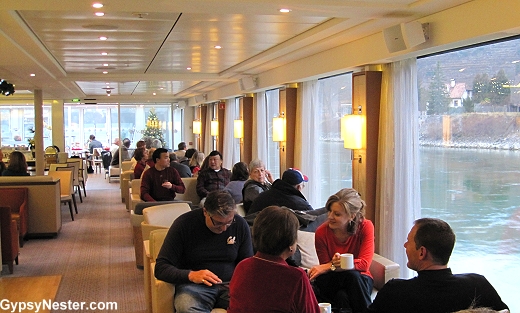
Late Afternoon: Got Melk?
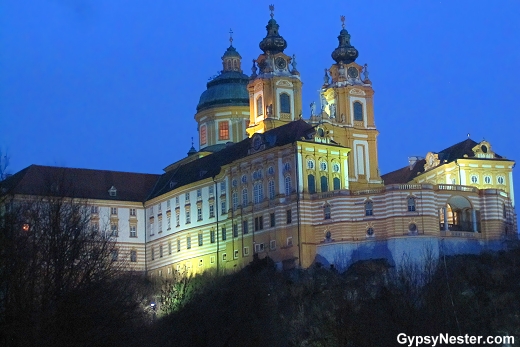 Late in the day we stop at Melk for a visit to the Benedictine Abbey.
Late in the day we stop at Melk for a visit to the Benedictine Abbey.
This is still an active monastery, and also houses a school for about nine hundred students.
Many of the old rooms are used as a museum now and we walk through these on our way to the incredibly impressive library.
Tens of thousands of volumes, some over a thousand years old, are kept, and still used by the monks.
The focal point of the abbey is the church. As beautiful as it is, the highlight for us are the two “catacomb saints” on display.
For some time during the 16th and 17th centuries the desire for relics became so great that the Vatican declared numerous unknown remains brought up from the catacombs under Rome to be saints.
The thinking seemed to be that since they came from Rome they must have been a martyr or great Christian of some sort, so they were dressed up in jewels and finery and sent off to churches in Germany, Austria and Switzerland.
See more photos of the inside of Melk’s incredible Benedictine Abbey!
Back on board the Skadi, our day ends with a bit of controversy during the Christmas trivia game. Our program director, Joey, asks how many reindeer pull Santa’s sleigh and quite a brew-ha-ha breaks out as to whether the correct answer is 8 or 9. Order is restored when he decides to accept either answer, eight in good weather and nine in bad.
Day Six: Spectacular Salzburg
Morning: Meeting Mozart
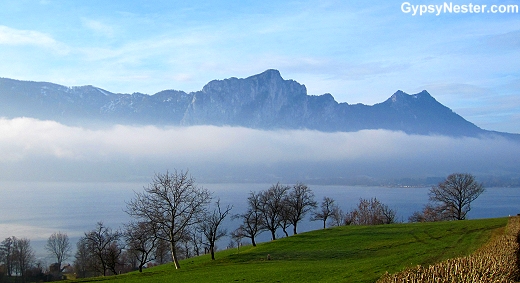
The fog trapped between Mondsee, (Moon Lake) and Drachenwand (Dragon’s Wall) adds to the spectacular scenery on the road to Salzburg.
Today The Skadi is docked in Linz, Austria, but we will take a bus for a short ride to Salzburg. One of the big advantages of river cruising is that we dock right in the heart of the cities we are visiting. Not true with Salzburg, but it is such a gem of a city that it would be a colossally bad mistake to skip the small detour.

Crossing the Salzach River toward Salzburg’s Old Town
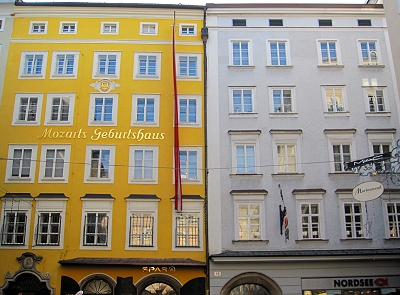
We will spend our day in Salzburg entirely within the walls of the old city, beginning and ending at the home where Mozart was born.
He was, after all, the original source of the sound of music coming from Salzburg.
Afternoon: Beer Hall-ing and Walking It Off!

Old Town’s ancient cobblestone streets are closed to vehicles and lined with shops and eateries, most sporting ornate wrought iron guild signs.
These signs date back to the 1400s and the guild system when craftsmen and tradesmen formed guilds, or associations, to manage business and train new apprentices.
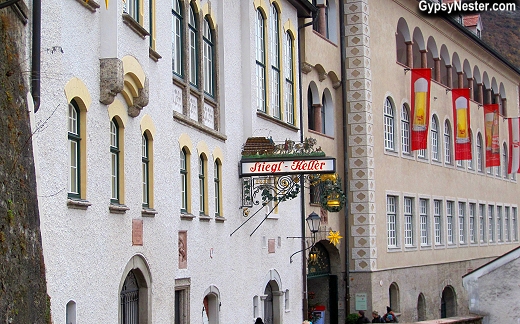
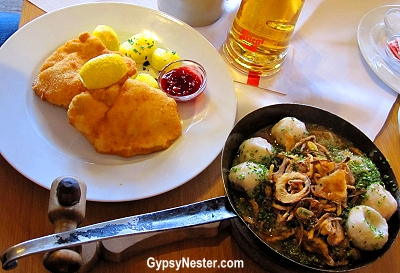
For lunch our fabulous guide pointed us to a classic beer hall, Stieglkeller, which of course features the local bräu, Stiegl, but also excellent authentic dishes. Not having had a schnitzel yet, that was a must, and when we saw six stuffed dumplings mit sauerkraut on the menu we knew what we had to do.

Like any good beer hall, big sturdy tables await mass quantities of food and drink, and animal heads, mostly the kind with antlers, adorn the walls.
This was not a light meal, so to walk it off we went along the lower wall of the castle. The side facing the city offers a great view over the entire old town.
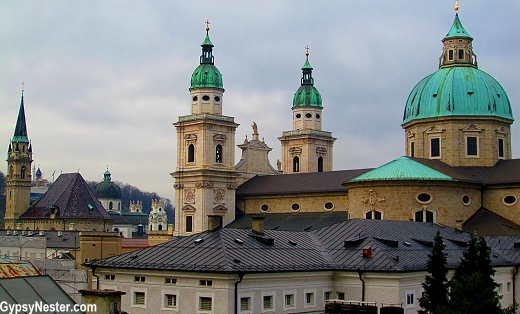
But the real reward came around the back side of the castle where we were greeted with a stunning view of the mountain Untersberg playing hide and seek with the clouds.
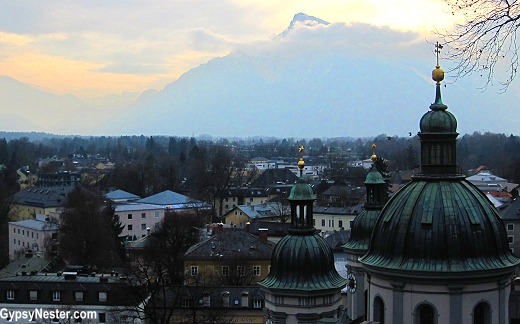
Late Afternoon: Christmas Market Ho! (Ho! Ho!)
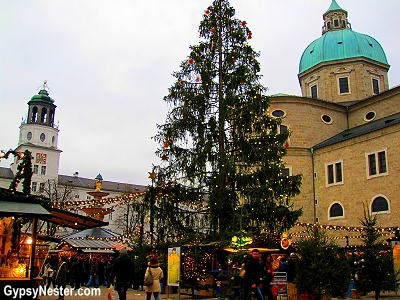
The Salzburg Christkindlmarkt is perhaps the biggest, and best Christmas market we have visited on our trip.
Food and drink are certainly available, but this market has much more to offer in the way of local crafts and unique items.
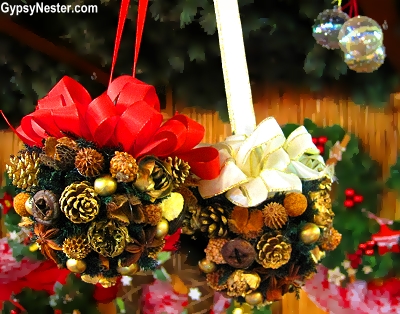
In addition to Salzburg’s famous Mozart chocolates we bought a gewürzstrauss, a traditional spice bouquet that makes anyplace smell like Christmas.
With only a couple of nights left on our cruise, tonight is the special Captain’s dinner. After a toast to a great crew and journey, the lobster is served. Quite a spread, five courses, from caviar to baked Alaska.

Day Seven: Passau Pleasures
Morning: Germany and Gingerbread
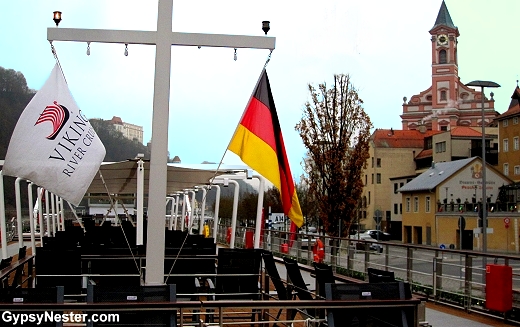
We are finishing our Christmas Market tour in Passau, Germany, where the River Inn and the River Ilz meet the Danube (Donau), and for this reason it is often called the City of Three Rivers.
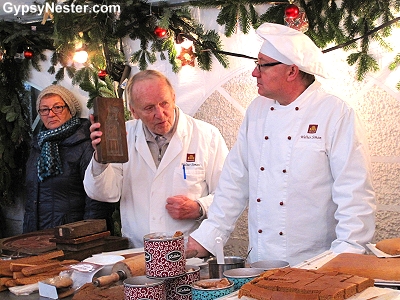
On our tour of the city we stop at Confiserie Café Simon for a demonstration on gingerbread, known here as Lebkuchen, which means loaf of life.
So our English translation is a misnomer, even more so since there is no ginger in gingerbread. The original simple recipe consists only of rye flour, honey and spices such as clove, nutmeg, and cinnamon. A more spicy version known as Gewürzlebkuchen (we learned in Salzburg that gewürzle means spice) includes molasses.
Do you love cooking classes like we do? Click here to see our classes from around the world!
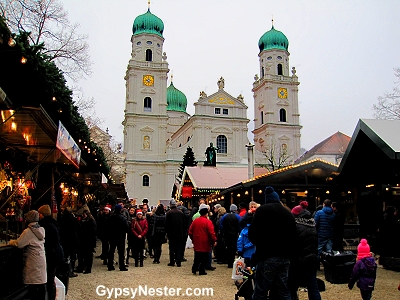
Our final Christmas market is in the square in front of St. Stephen’s Cathedral, a baroque church from 1688.
As with so much of the city, the church was built after the great fire of 1662. Before the fire, the church was not baroque, so afterwards it did need to be fixed. (ba-da-CHING!)
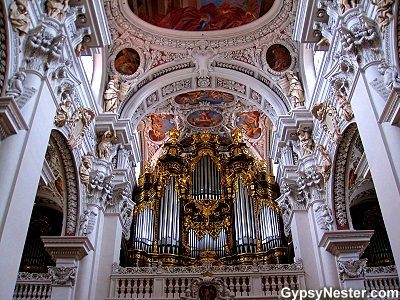
Inside, the largest cathedral organ in the world with 17,774 pipes, has been worked into the stucture. The organ currently has pipes in five different places, including inside the ceiling, all coordinated to play exactly together.
Concerts are held regularly and are a must-do when visiting.
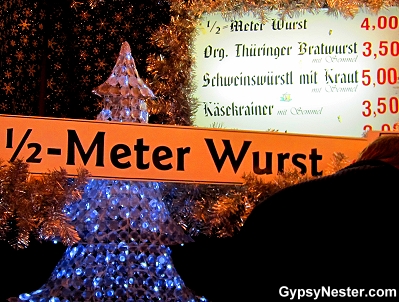
In the market we discovered something new, the 1/2 meter wurst. Almost two feet of sausage. Have we (meaning David) died and gone to heaven?
Unfortunately we just ate a huge lunch so we had no place to put half a meter of wurst.
Afternoon: David Goes Rogue
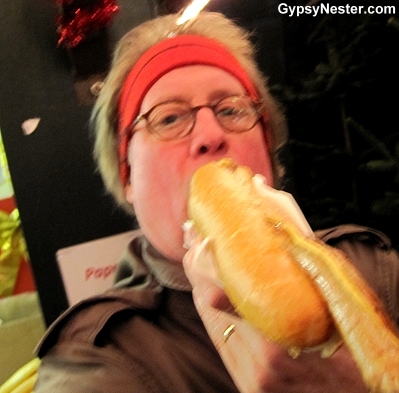
The thought of the half meter wurst wouldn’t leave me alone, so when Veronica decides to nap back on the ship, I sneak out to the market in search of a super sausage.
This indulgence must be captured on film, so I attempt the half-meter-wurst selfie. A difficult proposition considering that the sausage is almost as long as my arm.

Seeing my struggles, a helpful German woman offers to snap a photo, which I appreciate, but I really want the perspective of meat and bun at an arm’s length.
After seeing both photos, I think you’ll agree that the half-meter-wurst selfie is truly a work of art.
See more photos of the Passau Christmas Market and the full story of the infamous würst!
Evening: Time for reflection
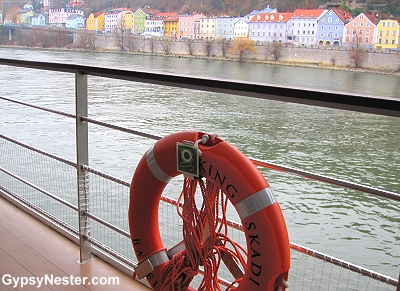
As our journey comes to an end we have some overall impressions.
First and foremost, the crew of The Skadi are superb, with a special shout out to Joey, our program director, Verona, the concierge, and Wilhelm, the hotel manager. They, and all the staff, made sure that every detail was attended to with near perfection.

Veronica in Skadi’s library. Free, unlimited wifi was available ship-wide, but this was one of her favorite haunts.
In addition, the tours were all well coordinated to allow free time while still seeing and learning about all of the highlights of each destination. The guides all lived in each city we were visiting, and so had valuable insights from a truly local perspective.
By docking near the city center of the incredible towns we visited, it was almost like having a hotel with a perfect location in each city. This is a different style of cruising, not so focused on shipboard activities as seeing the destinations, yet our time was always filled with educational or entertaining events. Several local music performers came on board, as well as lectures, demonstrations, and regional foods were offered every day.
Written aboard the Longship Skadi on her Christmas market river voyage along The Danube with stops in Budapest, Bratislavia, Vienna, Durnstein & Melk, and Passau. Thanks to Viking River Cruises for inviting us along and providing this adventure! As always, all opinions are our own.
David & Veronica, GypsyNester.com


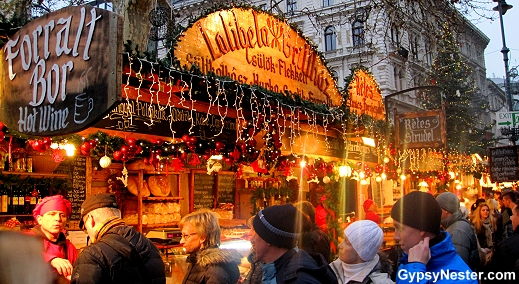
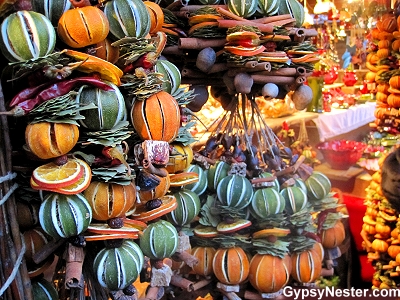
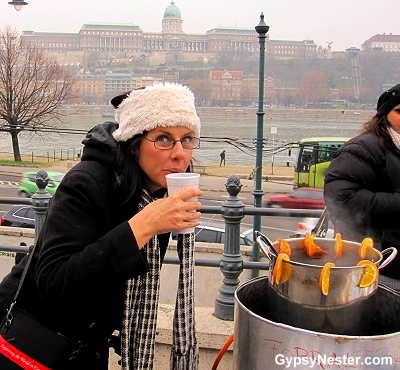
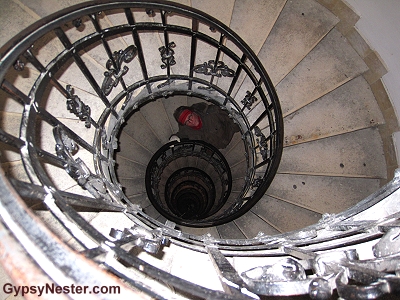
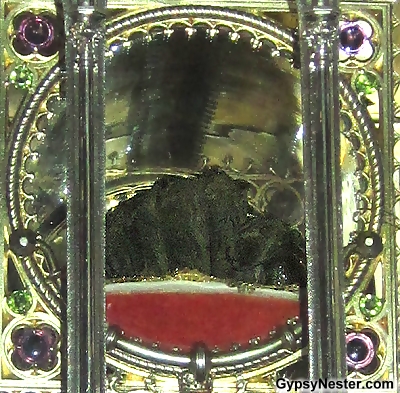
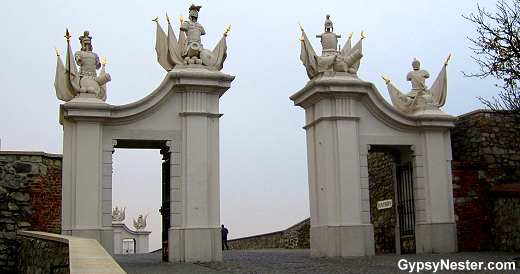

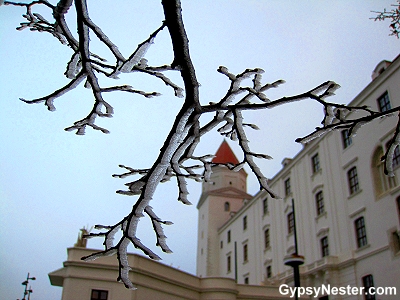
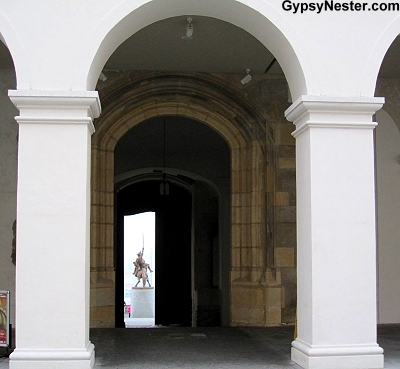

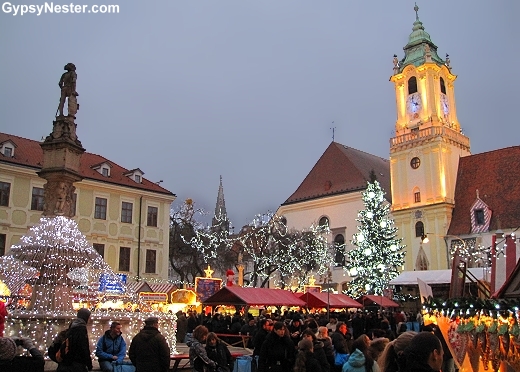

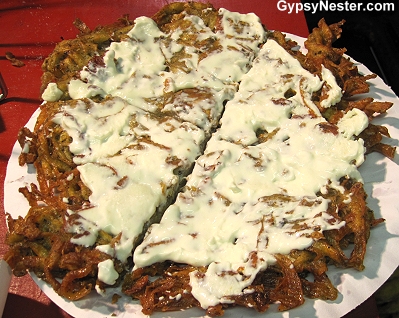
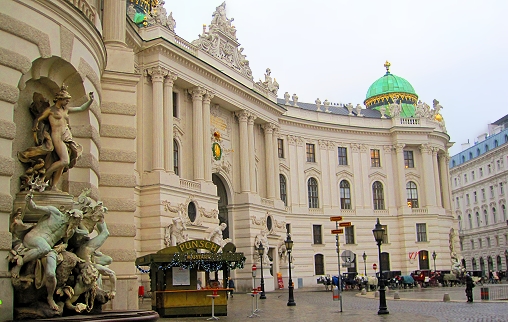

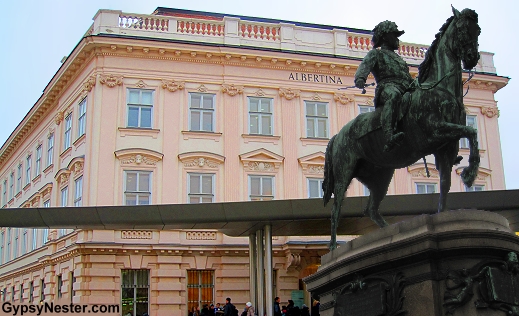
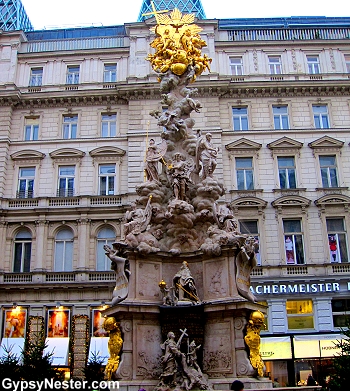
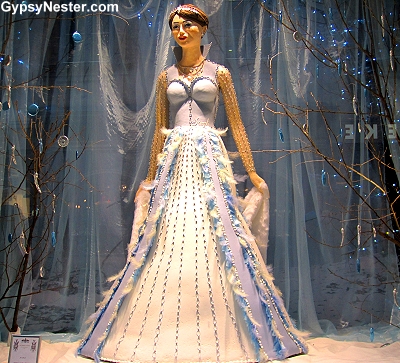
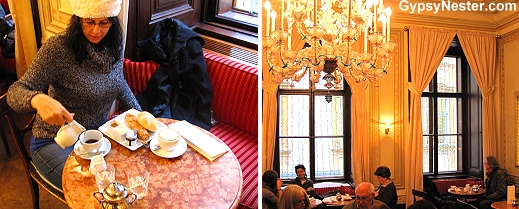

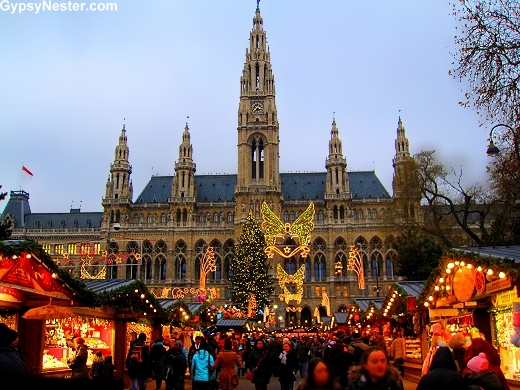


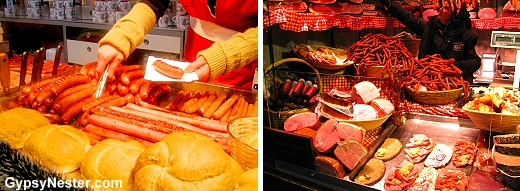
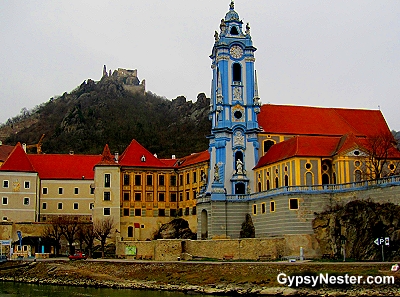


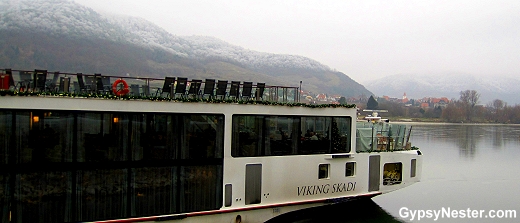

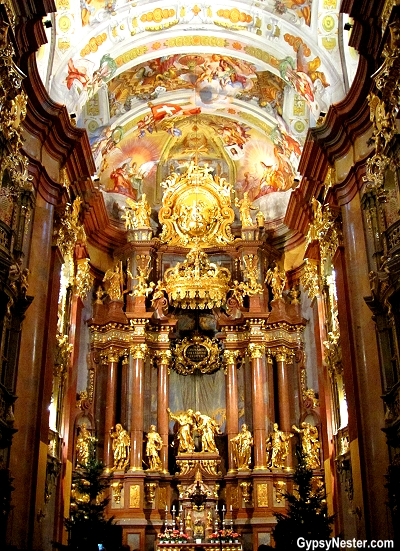
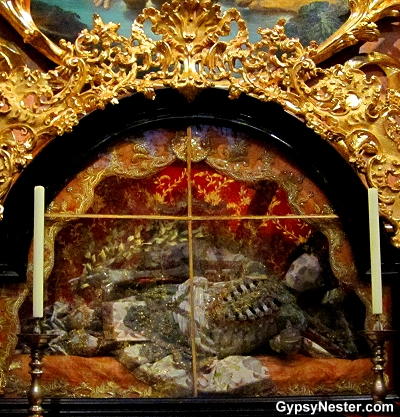

Your style is so unique compared to other people I have read stuff from.
Thank you for posting when you’ve got the opportunity, Guess I will just bookmark this site.
Oh! this seems like a super fun trip.
Great blog
It was great! Thanks.
Oh my! This post (and the pictures!) made me miss that European Christmas charm. What a unique way to explore these beautiful cities.
It really was a great way to see these cities and enjoy the wonderful markets.
Christmas markets, a very authentic and old tradition of Central Europe
Christmas markets are one of the most visible tradition of the central European region , created in the Late Middle Ages in the German-speaking part of Central Europe. The Vienna “December market” which dates back to 1294, was one of the earliest recorded examples of such a market.
Most market open up with the beginning of Advent, 4 weeks before Christmas, and usher in the Christmas season.
The focal point of these markets are the traditional Nativity Scene with their depiction of the birth of Jesus in the manger, surrounded by stall that sell things rustic hand made Christmas decorations , dried fruit and mulled wine to cast off the cold.
Thank you for sharing your trip. We are booked for Dec 2nd of 2015 Danube Waltz/Christmas. I was wondering how the weather was for your trip temp wise?
That’s right when we went and the weather was about what we expected. Cold but not terrible, hovering right around freezing, and generally grey but not much snow or rain. Bundle up and it’s fine. We also recommend some Glühwein to warm up. Have fun!
Thank you again for the advice. I lived many years in Chicago before moving to Las Vegas so I am certain we will manage. I am just glad to get some first hand knowledge. We will think of you both while having our Glühwein. Great site and Thanks again for sharing your travels.
Missed you by a year. A friend and I are going December 2, 2016! Danube Waltz.
GypsyNesters – Love your blog! Thank you for sharing.
Charles – how was the trip? Did you blog it? If so would you share the link? I’d love to read about it.
Thanks Patti!
Wow, what a full trip! You got so many amazing photos! Thanks for sharing it all!
How fun! I’m not really into cruising, but I’ve never tried a river cruise. I think I would really like one because the time because the distances is shorter and you sail right into the heart of the city. I would especially love to do a Christmas market river cruise!
It is a completely different experience from the big cruise ships, but both have their good points.
We returned from a similar cruise on December 21 on the Viking Idun, with similar ports of call, but starting in Nuremberg. Great time! Your post brought great memories – thanks so much. I took the Viking trip in China in August, only 5 days on the Yangtze and toured the other 13. Similar experience of excellence! You can’t go wrong on Viking!
The China trip looks great! You’re right about Viking, very good in every way.
The Stieglkeller in Salzburg was started in 1492- yes the same year Columbus discovered America. There is a fantastic museum of brewing and an excellent restaurant, the actual Steigl brewery is a must see, and also the salt mines are not to be missed!
Hi David and Veronica! Following you guys on your Viking River cruise. The beer and sausage looks yummy. We need to do a river cruise after seeing this. -Robert and Mary Ann
Hello, and Merry Christmas! It has been great and we can hardly get enough of the food and drink, it’s fantastic!
I’m booked on a Danube River Cruise next August coming the other way Prague, Nuremburg to Buda Pest. Thanks for giving me a fortaste of the sites and sights to come
Should be a great trip (and no doubt much warmer!) Have fun.
Looks like a great trip! Budapest is a great city to start. Are you staying in Europe when you are finished?
Budapest was fantastic! We are heading off from Munich the day after the cruise to see our kids for Christmas.
Taking the Skadi sounds like a great way to journey. It definitely helps that it looks pretty damn sleek on the inside.
Sleek is a good word to describe it.
This looks like a wonderful itinerary. I would love to do Christmas cruising on the Danube next year when we are officially EmptyNesters!!
Sounds like a great idea for your first empty nest Christmas.
The Christmas Market, food and scenery look so amazing. We would love to do this someday! Enjoy and Merry Christmas 🙂
Thanks Claudia, it has been wonderful, by all means if you get the chance you should!
I did October on the Danube! I think Christmas must be wonderful. Thank you for letting me live vicariously through you!
No doubt autumn was gorgeous. As always, our pleasure. ;
Why, that’s funny – we’ll be doing the return trip in a week! Are you two sticking around afterwards? Would love to hear any tips or ideas. I’ve been to most of the destinations, but it’s been ages!
Oh cool! We are flying out of Munich the last day so doubt our paths will cross. Too bad! Have fun!